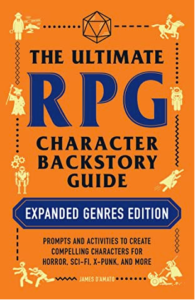 with the subsubtitle “Prompts and Activities to Create Compelling Characters for Horror, Sci-Fi, X-Punk, and More”
with the subsubtitle “Prompts and Activities to Create Compelling Characters for Horror, Sci-Fi, X-Punk, and More”
As an RPG nerd from way back, I was both deeply appreciative and somewhat perplexed by this book. I’ve never really had trouble dreaming up backstories for my characters, but can see how people with less active imaginations would find the many exercises and minigames in this guide to be super useful for filling out why their characters are the way they are when game begins. There’s even a helpful section in the book as to what to do in the event of a mid-game time jump, with players sitting around a table and drawing playing cards for prompts from the book (tho I’m unclear as to what James D’Amato means by making a visible break in the circle of cards. I assume that the cards are divided into stacks of four or are otherwise layered in some fashion?)
There were a few other sections where I was a little confused as to what was required of the reader. The strong and weak prompts for Standing Out In A Crowd in the Western section, for example, weren’t as clearly marked as they might have been. But overall this was a very thoughtfully designed handbook covering a variety of genres that, as the author notes, can be mixed and matched to accommodate the particular nuances of a game’s setting, using superhero prompts in a fantasy setting, for example, if you’re running a swords and sorcery story that involves secret identities. The language used throughout was also excellent, particularly in making this book feel welcoming for all players and reminding readers to avoid harmful tropes in our designs.
The Western section actually had the most interesting prompt of the book for me, on building a Quilt to illustrate the characters’ journey, with the very cute subsection titled “Ain’t That a Little Domestic?” There are so many great prompts in this book that can be used not only for filling in your RPG character’s psychological and physical profiles and history, but also for building relationships between your character and others, whether player or non-player, further strengthening ties in systems that prefer that parties start by already knowing one another in some way. Full disclosure: I’m not the hugest fan of systems like that, preferring to go in blind with my character and building bonds as I go.
But where I think this guide’s greatest strength lies is in how it sneakily gamifies character backstory creation by introducing many non-mainstream roleplaying mechanics. Whether it’s using multiple unusual dice or playing cards; choosing the forms of and creating correspondence, or simply making choices, sometimes arrayed, from the many, many tables provided (the Bond, Bleep, Blast table is a particular hoot,) readers are subtly encouraged to do more with their characters than merely roll the d20 and damage dice most are used to in vanilla D&D. It’s a great way to expand player’s horizons and get them feeling comfortable with different kinds of games and systems, as well as encouraging them to try some of the many different settings outlined here.
This is the kind of book that’s a useful addition to any gamer’s library, especially if they’re looking to really invest time and meaning in the characters they’ve created. This book is probably too involved for building characters for one-shots, but it does lay a thoughtful foundation for anyone looking to really make a hobby out of roleplaying, whether as player or GM. It’s even, as Mr D’Amato mentions in his introduction, a great help in writing genre fiction, game-related or otherwise.
The Ultimate RPG Character Backstory Guide: Expanded Genres Edition by James D’Amato was published June 14 2022 by Adams Media and is available from all good booksellers, including
